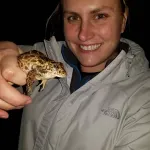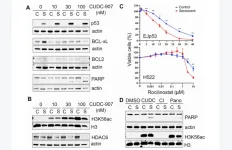(Press-News.org) LA JOLLA, CA—An anonymous San Diego resident has become a fascinating example of how the human immune system fights SARS-CoV-2. In a new investigation, scientists from La Jolla Institute for Immunology (LJI) have shown how antibodies, collected from this clinical study volunteer, bind to the SARS-CoV-2 "Spike" protein to neutralize the virus.
Although studies have shown antibodies bound to Spike before, this new research reveals how the original Moderna SARS-CoV-2 vaccine could prompt the body to produce antibodies against the later Omicron variants of SARS-CoV-2. The researchers also capture highly detailed, 3D structures of three promising neutralizing antibodies bound to Spike.
This important work shows exactly where Spike is vulnerable to human antibodies—and how future vaccines and antibody therapeutics might exploit these weaknesses. In fact, studies in mice suggest some of these antibodies may help prevent severe cases of COVID-19.
“To blunt the next pandemic and protect people from seasonal re-emergence of this one, we need antibodies of the broadest possible capacity—ones that are not escaped," says LJI President and CEO Erica Ollmann Saphire, Ph.D., senior author of the new Cell Reports study. “We found those in a vaccinated San Diegan.”
"Studying that person’s immune response in detail uncovered antibodies that are still effective against many Omicron variants," adds LJI Instructor Kathryn Hastie, Ph.D., co-leader of the study and Director of the LJI Antibody Discovery Center. "We now have to figure out how to boost these antibodies that we want over others that are less effective."
Taking on viral variants
Throughout the pandemic, scientists at LJI have gathered blood samples here in San Diego, and from labs around the world, with the goal of understanding the roles of different immune cells in fighting SARS-CoV-2. [Learn more about LJI leadership of the Coronavirus Immunotherapy Consortium (CoVIC)]
Antibodies are among the immune system's most elite fighters. These molecules are made by B cells and each antibody has a specific structure meant to bind to a specific target on a pathogen. It's as if B cells see a bullseye on a pathogen and then go to work making their arrows.
For the new study, the antibodies came from a clinical studies volunteer who received two doses of the Moderna SARS-CoV-2 vaccine. The Moderna vaccine works by prompting the body to make the Spike protein—glimpses of the viral bullseye—so it can begin work on its antibodies and other weaponry against the real virus.
The samples from the study volunteer were collected in early 2021—before the emergence of Omicron. That means any antibodies made by the volunteer were a result of vaccination, rather than exposure to Omicron.
The SARS-CoV-2 Omicron variant emerged in late 2021 and spread quickly. Omicron stood out from other variants because it contained mutations that helped it evade immune cell protection. Many antibodies designed to fight earlier SARS-CoV-2 variants couldn't hit their mark on Omicron.
Finding winning antibodies
Luckily, not everyone produces the same types of antibodies. In fact, the composition of virus-fighting cells and antibodies varies wildly in each person. For the new study, the researchers began with a pool of antibodies from the San Diego volunteer. Like many people who received the first two Moderna vaccine shots, this individual produced a robust pool of antibodies capable of neutralizing the ancestral D614G variant of SARS-CoV-2.
As new viral variants of concern emerged, the researchers tested this pool to see how many antibodies could still bind to the mutated virus.
”We found that this pool of antibodies could also neutralize other variants, such as Delta and Omicron,” says Hastie.
They found that the subject maintained moderate to high levels of antibodies against Beta, Delta and Omicron lineages BA.1, BA.1.1 and BA.2. Among these surviving antibodies, the researchers uncovered five antibodies that actually decreased the infectivity of BA.1 by more than 85 percent.
The researchers then took these five remaining antibodies through another battery of tests. One antibody, called 1C3, showed promise in blocking part of the infection process (when the virus's receptor binding domain interacts with human protein ACE2) but only against BA.1 and BA.2 lineages. Another antibody, 1H2, could also neutralize some Omicron lineages, but did so in a different way than 1C3. Meanwhile, antibody 2A10 was reactive to all SARS-CoV-2 Omicron lineages tested, including those that are most common now: XBB and BQ1.
Mapping out antibody targets
The scientists went on to map out these vulnerabilities on Spike using a high-resolution imaging technique called cryo-electron microscopy. "We were really interested to see how these antibodies recognize the Spike protein and structure," says LJI Postdoctoral Fellow Xiaoying Yu, who co-led the new study with Hastie. "This structural work lets us see exactly how the antibodies interact with the protein and how they can neutralize the virus."
The imaging work revealed that two of the promising antibodies bind to the SARS-CoV-2 Spike by latching onto two parts of the protein at once. By capturing Spike in a sort of hug of death, these antibodies lock the viral structure in place to halt infection. This finding is consistent with another recent Cell Reports study from the Saphire Lab showing the importance of bivalent antibodies against SARS-CoV-2 variants.
Could these three promising antibodies be recreated in an antibody therapeutic to treat COVID-19? The results from a mouse model are encouraging. The LJI team found that each antibody by itself could indeed reduce the viral load in the lungs in mice infected with SARS CoV-2 BA.1 and BA.2.
Going forward, the researchers plan to run more human antibodies through this same pipeline at LJI—from antibody isolation to screening, structural analysis, and animal model experiments. "We can carry out the entire pipeline of antibody discovery now," says Yu. "This research will help us combat the variants we have right now and give us targets for future vaccine development and therapeutics."
Additional authors of the study, "Potent, omicron-neutralizing antibodies isolated from a patient vaccinated 6 months before omicron emergence," were Fernanda A. Sosa Batiz, Dawid Zyla, Stephanie S. Harkins, Chitra Hariharan, Hal Wasserman, Michelle A. Zandonatti, Robyn Miller, Erin Maule, Kenneth Kim, Kristen Valentine, and Sujan Shresta.
This research was supported by the National Institutes of Health (grant NIH U19 AI142790-02S1), the GHR Foundation, the Swiss National Science Foundation Early Postdoc Mobility Fellowship (P2EZP3_195680), a Postdoc Mobility Fellowship (P500PB_210992), and an American Association of Immunologists Career Reentry Fellowship.
DOI: 10.1016/j.celrep.2023.112421
END
Even as SARS-CoV-2 mutates, some human antibodies fight back
A 'cocktail' of human antibodies shows promise in fighting severe SARS-CoV-2 infections
2023-04-26
ELSE PRESS RELEASES FROM THIS DATE:
BioOne presents 2023 BioOne Ambassador Award to five early career scientists
2023-04-26
WASHINGTON, D.C., April 25, 2023 – BioOne proudly announces the 2023 recipients of the BioOne Ambassador Award. Now in its sixth year, this prestigious award recognizes early-career researchers in the biological, ecological, environmental sciences who demonstrate creative approaches to science communication thereby fostering greater science literacy and aiding in the understanding of the natural world. BioOne Ambassadors are nominated by BioOne publishing partners and each winning author will receive a $1,000 award, and have their work promoted through BioOne’s multiple channels.
This year’s ...
Characterization of the HDAC/PI3K inhibitor CUDC-907 as a novel senolytic
2023-04-26
“The mechanisms of induction of senescent cell death by CUDC-907 remain to be fully elucidated.”
BUFFALO, NY- April 25, 2023 – A new research paper was published in Aging (listed by MEDLINE/PubMed as "Aging (Albany NY)" and "Aging-US" by Web of Science) Volume 15, Issue 7, entitled, “Characterization of the HDAC/PI3K inhibitor CUDC-907 as a novel senolytic.”
The accumulation of senescent cells has an important role in the phenotypical changes observed in aging and in many age-related pathologies. Thus, the strategies designed to prevent these effects, collectively ...
Transparent labeling of training data may boost trust in artificial intelligence
2023-04-26
UNIVERSITY PARK, Pa. — Showing users that visual data fed into artificial intelligence (AI) systems was labeled correctly might make people trust AI more, according to researchers. The findings also may pave the way to help scientists better measure the connection between labeling credibility, AI performance, and trust, the team added.
In a study, the researchers found that high-quality labeling of images led people to perceive that the training data was credible and they trusted the AI system more. ...
A meeting in the mitten: Water, rock, wonderland
2023-04-26
25 April 2023
The Geological Society of America
Release no. 23-20
Contact: Justin Samuel
+1-303-357-1026
jsamuel@geosociety.org
For Immediate Release
A Meeting in the Mitten: Water, Rock, Wonderland
Boulder, Colo., USA: The 2023 Geological Society of America North-Central
Section Meeting will be held on 4–5 May in Grand Rapids, Michigan, USA. We
are pleased to announce a wide-ranging set of theme sessions, field trips,
and short courses aligned with our meeting theme: A Meeting in the Mitten:
Water, Rock, Wonderland.
...
Mums with SLE at double the risk of having premature or growth restricted babies
2023-04-26
Mothers with the long term autoimmune disorder, systemic lupus erythematosus, or SLE for short, run more than double the risk of giving birth to a premature or growth restricted baby, finds a 10-year nationwide audit of hospital admissions records in the US and published online in the open access journal RMD Open.
And these mothers are nearly 4 times as likely to need a blood transfusion and 15 times as likely to develop kidney failure during delivery as mothers without the condition, the audit shows.
Rates of death and serious illness among new mothers are increasing in the USA, likely due to rising rates of obesity, underlying conditions, and older age ...
Mixing theory, observation to envision warmer world
2023-04-26
Climate changes are conjuring a whirlwind ride that seems to present some creatures opportunities to thrive. Scientists scripting supercharged scenarios caution the difference between seasonal coping and long-term adaption is vast – and tricky to predict.
Michigan State University biologists have studied damselflies – which resemble dragonflies and are abundant as both predator and prey in wetlands – to understand what happens throughout their lifecycle from nymph to winged insect, along with what they eat when summers grow warmer and longer.
Their work in this week’s Proceedings of the Royal Society B has a twist – ...
Higher rates of HIV diagnoses found amongst mental health service users
2023-04-26
Press release: Under Embargo until Wednesday 26th April 2023, 12:05am BST
Higher rates of HIV diagnoses found amongst mental health service users
New National Institute for Health and Care Research Maudsley BRC supported research has found HIV is 2.5 times more frequent in people who use mental health services than the general population in South London. The paper was published today in BMJ Open.
HIV is 2.5 times more common in people who use mental health services than the general population in South London.
The researchers, at King’s College London, found that 2.5% of people who have had contact with mental health services had a recorded diagnosis of ...
Almost half of people with concussion still show symptoms of brain injury six months later
2023-04-26
Even mild concussion can cause long-lasting effects to the brain, according to researchers at the University of Cambridge. Using data from a Europe-wide study, the team has shown that for almost a half of all people who receive a knock to the head, there are changes in how regions of the brain communicate with each other, potentially causing long term symptoms such as fatigue and cognitive impairment.
Mild traumatic brain injury – concussion – results from a blow or jolt to the head. It can occur as a result of a fall, a sports injury or from a cycling accident or car crash, ...
Astronomers solve the 60-year mystery of quasars – the most powerful objects in the Universe
2023-04-26
**Strictly embargoed until 01:01 (BST) Wednesday 26 April 2023**
Astronomers solve the 60-year mystery of quasars – the most powerful objects in the Universe
First discovered 60 years ago, quasars can shine as brightly as a trillion stars packed into a volume the size of our Solar System, but until now it has remained a mystery what could trigger such powerful activity
By observing 48 galaxies that host quasars and comparing them to over 100 non-quasar galaxies, scientists discovered that the phenomenon is ignited by galaxies colliding
When two galaxies collide, gravitational forces ...
Social media fuelling eating disorders among female athletes, research shows
2023-04-26
Social media is fuelling eating disorders among female athletes who feel they must achieve the ‘ideal’ body, according to experts.
Dr Kathryn Vidlock and Catherine Liggett, who have both competed in collegiate athletics, and dietician Andrew Dole warn that nutrition ‘myths’ posted by fitness influencers, exercise-related ‘fitspiration’ images on Instagram, and photoshopping are having a direct impact on sportswomen.
Their new book Spring Forward: Balanced Eating, Exercise, and Body Image in ...
LAST 30 PRESS RELEASES:
Injectable breast ‘implant’ offers alternative to traditional surgeries
Neuroscientists devise formulas to measure multilingualism
New prostate cancer trial seeks to reduce toxicity without sacrificing efficacy
Geometry shapes life
A CRISPR screen reveals many previously unrecognized genes required for brain development and a new neurodevelopmental disorder
Hot flush treatment has anti-breast cancer activity, study finds
Securing AI systems against growing cybersecurity threats
Longest observation of an active solar region
Why nail-biting, procrastination and other self-sabotaging behaviors are rooted in survival instincts
Regional variations in mechanical properties of porcine leptomeninges
Artificial empathy in therapy and healthcare: advancements in interpersonal interaction technologies
Why some brains switch gears more efficiently than others
UVA’s Jundong Li wins ICDM’S 2025 Tao Li Award for data mining, machine learning
UVA’s low-power, high-performance computer power player Mircea Stan earns National Academy of Inventors fellowship
Not playing by the rules: USU researcher explores filamentous algae dynamics in rivers
Do our body clocks influence our risk of dementia?
Anthropologists offer new evidence of bipedalism in long-debated fossil discovery
Safer receipt paper from wood
Dosage-sensitive genes suggest no whole-genome duplications in ancestral angiosperm
First ancient human herpesvirus genomes document their deep history with humans
Why Some Bacteria Survive Antibiotics and How to Stop Them - New study reveals that bacteria can survive antibiotic treatment through two fundamentally different “shutdown modes”
UCLA study links scar healing to dangerous placenta condition
CHANGE-seq-BE finds off-target changes in the genome from base editors
The Journal of Nuclear Medicine Ahead-of-Print Tip Sheet: January 2, 2026
Delayed or absent first dose of measles, mumps, and rubella vaccination
Trends in US preterm birth rates by household income and race and ethnicity
Study identifies potential biomarker linked to progression and brain inflammation in multiple sclerosis
Many mothers in Norway do not show up for postnatal check-ups
Researchers want to find out why quick clay is so unstable
Superradiant spins show teamwork at the quantum scale
[Press-News.org] Even as SARS-CoV-2 mutates, some human antibodies fight backA 'cocktail' of human antibodies shows promise in fighting severe SARS-CoV-2 infections






